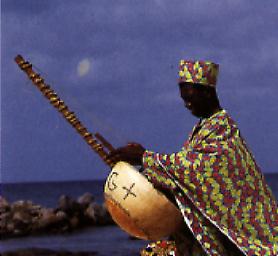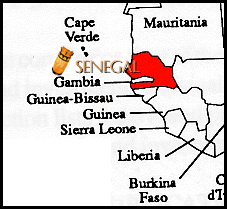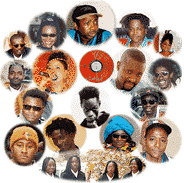 Senegal,
and its well-developed music industry, have produced some of the most globally successful
African bands and artists. Their exploration of contemporary sounds have been balanced
with the incorporation of traditional local instrumentaion such as the Wolof sabar
and tama drums, and Mandinka kora. The independence year of
1960 marked a historically important year for Senegal's musical development. Kinshasa band
Ryco Jazz toured, showcasing their strong Zairean rumba influence to a country that had
long loved the Cuban son, charanga and rumba sounds of bands like Orchestra
Aragaon and Johnny Pacheco. In August of 1960, Ibra Kasse formed the Star Band
du Dakar with singers Labah Sosseh and Pape Seck. Star Band launched the
careers of many Senegalese musicians and fathered a number of musical offspring including Star
Number One (which became Orchestra Number One and Number One de Senegal), Etoile
2000, Orchestra Baobab, and Etoile de Dakar.
Senegal,
and its well-developed music industry, have produced some of the most globally successful
African bands and artists. Their exploration of contemporary sounds have been balanced
with the incorporation of traditional local instrumentaion such as the Wolof sabar
and tama drums, and Mandinka kora. The independence year of
1960 marked a historically important year for Senegal's musical development. Kinshasa band
Ryco Jazz toured, showcasing their strong Zairean rumba influence to a country that had
long loved the Cuban son, charanga and rumba sounds of bands like Orchestra
Aragaon and Johnny Pacheco. In August of 1960, Ibra Kasse formed the Star Band
du Dakar with singers Labah Sosseh and Pape Seck. Star Band launched the
careers of many Senegalese musicians and fathered a number of musical offspring including Star
Number One (which became Orchestra Number One and Number One de Senegal), Etoile
2000, Orchestra Baobab, and Etoile de Dakar.
Orchestra Baobab, which formed in 1970, represented in its early stages the
older, slow, rumba sounds which were to give way to the more modern energetic rhythms of mbalax.
The band at various times featured such vocalists as Thione Seck, Balla Sidibe and Rodolphe
Gomis as well as the unique guitar work of Barthelem Attiso, and combined
Wolof, Mandinka, Guinea Bissau, and Spanish influences. While later evolutions of the band
turned to a more tama-oriented mbalax sound, such recordings as the "Legendary 1982
Session" of Pirates Choice feature the timeless, sweet rumba side of Baobab.
In the early 1990's Baobab/Star survivors Medoune Diallo and Pape Seck
teamed up with Senegalese super producer Ibrahim Sylla and a battery of Cuban and
Puerto Rican greats to pay hommage to the Latin-African fusion. This recording studio
creation, Africando, produced several exceptional recordings for the Stern's label.
Sylla himself deserves mention as Africa's number producer who has worked with a
pan-African collection of stars from Mali and Senegal to Cameroon and Zaire.
 But it is mbalax
which defines the contemporary Senegalese musical signature. Another Star child, Etoile de
Dakar, was the first official band of a young Wolof singer destined to became Senegal's
major superstar. Youssou N'Dour had a professional reputation as "Le Petit
Prince de Dakar" by his early teens and made his first recording session, at the age
of 19, with the Star Band in 1978. The following year he broke off with some members of
the group to form Etoile de Dakar. When N' Dour moved to Paris, he reorganized the band as
Super Etoile. N'Dour helped to create, develop and promote mbalax, a
Wolof-dominated style that incorporates traditional rhythms of the sabar and bugarabu
drums, as well as the "talking drum" bursts of the tama. N'Dour has continued to
forge ahead, bringing in more Western elements but never losing his mbalax roots. In
recent years he has also formed a recording and production studio (Xippi or "Eyes
Open") in Dakar, which has been used by such other musical notables as Senegal's
foremost female vocalist, griot- descendent Kine Lam.
But it is mbalax
which defines the contemporary Senegalese musical signature. Another Star child, Etoile de
Dakar, was the first official band of a young Wolof singer destined to became Senegal's
major superstar. Youssou N'Dour had a professional reputation as "Le Petit
Prince de Dakar" by his early teens and made his first recording session, at the age
of 19, with the Star Band in 1978. The following year he broke off with some members of
the group to form Etoile de Dakar. When N' Dour moved to Paris, he reorganized the band as
Super Etoile. N'Dour helped to create, develop and promote mbalax, a
Wolof-dominated style that incorporates traditional rhythms of the sabar and bugarabu
drums, as well as the "talking drum" bursts of the tama. N'Dour has continued to
forge ahead, bringing in more Western elements but never losing his mbalax roots. In
recent years he has also formed a recording and production studio (Xippi or "Eyes
Open") in Dakar, which has been used by such other musical notables as Senegal's
foremost female vocalist, griot- descendent Kine Lam.
Other important progenitors of mblax included Super Diamono which began in 1975
with singer Omar Pene and guitarist Ismael Lo. Lo left the band in 1984 and
went on to solo success. Other major groups of the 1970's and 1980's include Le Xalam,
who blended folkloric music with contemporary jazz and rock, and Toure Kunda who
hailed from the southern Casamance province and created an Afro-rock fusion with a mix of
Soninke ("toure" means family in Soninke), Mandinke, Peul, Diolla, Wolof and
Portugese Creole vocals. While much of Senegelese music has been dominated by the Wolof
majority, singer Baaba Maal has been a champion of the Pulaar (Fulani) speaking
Toucouleur people of northern Senegal. Maal abandoned law school studies in favor of
music, and has used his art as a platform for his intellectual and social causes. His
guitarist and friend, Mansour Seck, has helped define his succesful style.
Long-term artists as well as newer arrivals continue to explore both traditional and
contemporary sounds as well as mixtures of the two. A Senegalese rap style called tassou
has become popular and a new group who rap in Wolof and French, Positive Black Force,
released a 1996 CD for the U.S.based Mango label. Whether at home or abroad, it is certain
that Senegalese artists will continue to be an important presence in defining the
directions and possibilities that await Afro-pop.
 "The
base of all music in Sénégal is traditional," says Baaba Maal, one of the finest
contemporary musical artists in Africa; and, traditional Sénégalese music may be the
foundation for much of the music of the Western world. Aficionados of country blues,
calypso, reggae, beguine, and rap, whether or not they recognise it, hear echoes of the
musical rhythms of the land of Teranga, the gateway to Africa.
"The
base of all music in Sénégal is traditional," says Baaba Maal, one of the finest
contemporary musical artists in Africa; and, traditional Sénégalese music may be the
foundation for much of the music of the Western world. Aficionados of country blues,
calypso, reggae, beguine, and rap, whether or not they recognise it, hear echoes of the
musical rhythms of the land of Teranga, the gateway to Africa.
Existing traditional Sénégalese rhythms, such as the Yela, which come
from the old Empire and predate all colonialization of Sénégal, still resound thanks to
musicians such as Baaba Maal. Sénégalese kings used Yela to call the people of the
Empire together so that they could listen to important events.
Yela is the music of women, as it mimics the sound they made when
pounding grain. When performing the Yela, some women would hit the stressed third beat on
their calabashes, while others carried the weaker first beat by clapping their hands. It
is the Yela Jimmy Cliff heard when he visited Dakar; and it is reputed to be the primary
influence for the development of reggae in the Caribbean.
Some of the traditional musical instruments still being used to make
music in Sénégal are the twenty-one stringed kora, the violin-like riti, the hoddu and
the seven-stringed African guitar.
Asly Fouta, a group of seventy musicians, is, according to Baaba Maal,
"a university for the traditional African music" being central to the education
of many great music makers. It is with this group that many have learnt to play most or
all of the traditional instruments.
Today, the Pekan songs of the northern fisherman, the Gumbala chants of
ancient warriors, the Dilere ditties of weavers plaiting their threads, and Yela sung by
women, can still be heard, beautifully integrated with the modern musical rhythms. Music
in Sénégal carries the country's art, history, and dance all wrapped up in one. To know
Sénégal, and to understand some of it's impact on the rest of the world, listen to its
beautiful music.
La référence musicale du Sénégal est sans conteste Youssou N'DOUR
 Senegal,
and its well-developed music industry, have produced some of the most globally successful
African bands and artists. Their exploration of contemporary sounds have been balanced
with the incorporation of traditional local instrumentaion such as the Wolof sabar
and tama drums, and Mandinka kora. The independence year of
1960 marked a historically important year for Senegal's musical development. Kinshasa band
Ryco Jazz toured, showcasing their strong Zairean rumba influence to a country that had
long loved the Cuban son, charanga and rumba sounds of bands like Orchestra
Aragaon and Johnny Pacheco. In August of 1960, Ibra Kasse formed the Star Band
du Dakar with singers Labah Sosseh and Pape Seck. Star Band launched the
careers of many Senegalese musicians and fathered a number of musical offspring including Star
Number One (which became Orchestra Number One and Number One de Senegal), Etoile
2000, Orchestra Baobab, and Etoile de Dakar.
Senegal,
and its well-developed music industry, have produced some of the most globally successful
African bands and artists. Their exploration of contemporary sounds have been balanced
with the incorporation of traditional local instrumentaion such as the Wolof sabar
and tama drums, and Mandinka kora. The independence year of
1960 marked a historically important year for Senegal's musical development. Kinshasa band
Ryco Jazz toured, showcasing their strong Zairean rumba influence to a country that had
long loved the Cuban son, charanga and rumba sounds of bands like Orchestra
Aragaon and Johnny Pacheco. In August of 1960, Ibra Kasse formed the Star Band
du Dakar with singers Labah Sosseh and Pape Seck. Star Band launched the
careers of many Senegalese musicians and fathered a number of musical offspring including Star
Number One (which became Orchestra Number One and Number One de Senegal), Etoile
2000, Orchestra Baobab, and Etoile de Dakar.  But it is mbalax
which defines the contemporary Senegalese musical signature. Another Star child, Etoile de
Dakar, was the first official band of a young Wolof singer destined to became Senegal's
major superstar. Youssou N'Dour had a professional reputation as "Le Petit
Prince de Dakar" by his early teens and made his first recording session, at the age
of 19, with the Star Band in 1978. The following year he broke off with some members of
the group to form Etoile de Dakar. When N' Dour moved to Paris, he reorganized the band as
Super Etoile. N'Dour helped to create, develop and promote mbalax, a
Wolof-dominated style that incorporates traditional rhythms of the sabar and bugarabu
drums, as well as the "talking drum" bursts of the tama. N'Dour has continued to
forge ahead, bringing in more Western elements but never losing his mbalax roots. In
recent years he has also formed a recording and production studio (Xippi or "Eyes
Open") in Dakar, which has been used by such other musical notables as Senegal's
foremost female vocalist, griot- descendent Kine Lam.
But it is mbalax
which defines the contemporary Senegalese musical signature. Another Star child, Etoile de
Dakar, was the first official band of a young Wolof singer destined to became Senegal's
major superstar. Youssou N'Dour had a professional reputation as "Le Petit
Prince de Dakar" by his early teens and made his first recording session, at the age
of 19, with the Star Band in 1978. The following year he broke off with some members of
the group to form Etoile de Dakar. When N' Dour moved to Paris, he reorganized the band as
Super Etoile. N'Dour helped to create, develop and promote mbalax, a
Wolof-dominated style that incorporates traditional rhythms of the sabar and bugarabu
drums, as well as the "talking drum" bursts of the tama. N'Dour has continued to
forge ahead, bringing in more Western elements but never losing his mbalax roots. In
recent years he has also formed a recording and production studio (Xippi or "Eyes
Open") in Dakar, which has been used by such other musical notables as Senegal's
foremost female vocalist, griot- descendent Kine Lam.  "The
base of all music in Sénégal is traditional," says Baaba Maal, one of the finest
contemporary musical artists in Africa; and, traditional Sénégalese music may be the
foundation for much of the music of the Western world. Aficionados of country blues,
calypso, reggae, beguine, and rap, whether or not they recognise it, hear echoes of the
musical rhythms of the land of Teranga, the gateway to Africa.
"The
base of all music in Sénégal is traditional," says Baaba Maal, one of the finest
contemporary musical artists in Africa; and, traditional Sénégalese music may be the
foundation for much of the music of the Western world. Aficionados of country blues,
calypso, reggae, beguine, and rap, whether or not they recognise it, hear echoes of the
musical rhythms of the land of Teranga, the gateway to Africa.